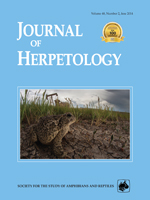Fragmentation of natural landscapes by linear anthropogenic features, such as roads, has several negative consequences, including decreasing connectivity between habitats, inhibiting animal movements, and isolating populations. Roads limit animal movements through behavioral avoidance and mortality during crossing attempts. We investigated the impact of a road network on the movement patterns of Blanding's Turtles (Emydoidea blandingii) in Québec, Canada. We tested the hypothesis that roads act as a barrier to movements. We monitored 52 Blanding's Turtles (22 females, 24 males, and 6 juveniles) via radiotelemetry during their active season from May to August 2010. Road avoidance was quantified for each individual by comparing the number of inferred road crossings with the number of expected road crossings predicted by 1,000 movement path randomizations. Overall, Blanding's Turtles significantly avoided crossing roads. Roads were a significant barrier to movement for 3–6 of the 52 turtles, and an individual's tendency to cross roads was not influenced by its sex or by the road surface (unpaved or paved). Preserving demographic and genetic connectivity of animal populations separated by roads is a major conservation challenge for species at risk such as the Blanding‘s Turtle.
How to translate text using browser tools
1 June 2014
Blanding's Turtles ( Emydoidea blandingii) Avoid Crossing Unpaved and Paved Roads
Catherine L. Proulx,
Gabrielle Fortin,
Gabriel Blouin-Demers
ACCESS THE FULL ARTICLE

Journal of Herpetology
Vol. 48 • No. 2
June 2014
Vol. 48 • No. 2
June 2014




